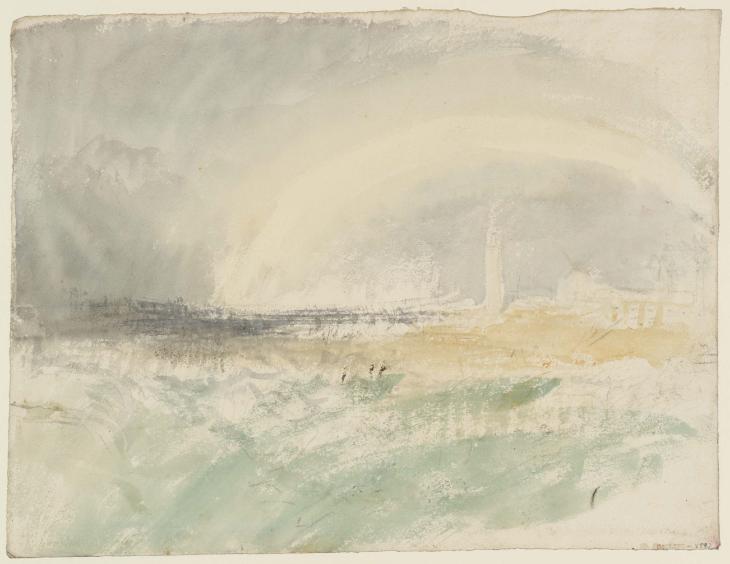Joseph Mallord William Turner ?Firing Rockets at Great Yarmouth, Possibly Related to 'Life-Boat and Manby Apparatus Going Off' c.1831
Joseph Mallord William Turner,
?Firing Rockets at Great Yarmouth, Possibly Related to 'Life-Boat and Manby Apparatus Going Off'
c.1831
Joseph Mallord William Turner 1775–1851
?Firing Rockets at Great Yarmouth, Possibly Related to ‘Life-Boat and Manby Apparatus Going Off’ c.1831
D35977
Turner Bequest CCCLXIV 134
Turner Bequest CCCLXIV 134
Pencil and watercolour on white wove paper, 220 x 289 mm
Blind-stamped with Turner Bequest monogram towards bottom right
Inscribed by ?John Ruskin in blue ink ‘1597’ bottom right
Stamped in black ‘CCCLXIV – 134’ bottom right
Blind-stamped with Turner Bequest monogram towards bottom right
Inscribed by ?John Ruskin in blue ink ‘1597’ bottom right
Stamped in black ‘CCCLXIV – 134’ bottom right
Accepted by the nation as part of the Turner Bequest 1856
Exhibition history
1951
Aquarelle aus dem Turner-Nachlass im Britischen Museum veranstaltet vom British Council, Düsseldorf, Wiesbaden, Mannheim, Munich, Nuremberg: September or October 1950–March 1951, and September 1951–April 1952 (29, as ‘Raketensignale an der Küste , wahrscheinlich bei Yarmouth’, c.1830).
1983
J.M.W. Turner, à l’occasion du cinquantième anniversaire du British Council, Galeries nationales du Grand Palais, Paris, October 1983–January 1984 (255, as ‘Etude d’arc-en-ciel sur une jetée’, ?1845, reproduced).
1998
Turner and the Scientists, Tate Gallery, London, March–June 1998 (67, as ‘Firing Rockets off the Coast’, mid 1820s, reproduced).
2009
Water Colours: From the Source to the Sea, Tate Britain, London, August 2009–July 2010 (no catalogue, as ‘Firing Rockets on the Coast. ?At Yarmouth’, after c.1840).
2013
Turner & the Sea, National Maritime Museum, Greenwich, November 2013–April 2014, Peabody Essex Museum, Salem, Massachusetts, May–September 2014 (104, as ‘Firing Rockets on the Coast’, after 1830, reproduced in colour).
References
1830
A.J. Finberg, A Complete Inventory of the Drawings of the Turner Bequest, London 1909, vol.II, p.1185, CCCLXIV 134, as ‘Firing rockets on the coast. Probably at Yarmouth. Cf. Oil picture at V. & A. Museum, of “Lifeboat Manby Apparatus, &c.” exhibited R.A., 1831’, after c.1830.
1830
J. Isaacs, Aquarelle aus dem Turner-Nachlass im Britischen Museum veranstaltet vom British Council, exhibition British Council German tour, 1950, p.14 no.29, as ‘29, as ‘Raketensignale an der Küste , wahrscheinlich bei Yarmouth’, c.1830.
1968
Graham Reynolds, Bicentenary Exhibition 1768–1968, exhibition catalogue, Royal Academy of Arts, London 1968, p.85 under no.163.
1969
Graham Reynolds, ‘Turner at East Cowes Castle’ in Victoria and Albert Museum Yearbook, vol.I, London 1969, pp.76, 77 fig.13, as ‘Firing Rockets at Yarmouth’.
1845
Andrew Wilton in John Gage, Jerrold Ziff, Nicholas Alfrey and others, J.M.W. Turner, à l’occasion du cinquantième anniversaire du British Council, exhibition catalogue, Galeries nationales du Grand Palais, Paris 1983, p.305 no.255, as ‘Etude d’arc-en-ciel sur une jetée’, ?1845, reproduced.
1984
Martin Butlin and Evelyn Joll, The Paintings of J.M.W. Turner, revised ed., New Haven and London 1984, p.189 under no.336.
1998
James Hamilton, Turner and the Scientists, exhibition catalogue, Tate Gallery, London 1998, p.139 no.67, as ‘Firing Rockets off the Coast’, mid 1820s, fig.89.
1996
Turner 1775 1851, Découvrons l’art, Paris 1996, p.7 ill.i, as ‘Etude d’arc-en-ciel sur une jetée’, 1845.
1997
Eric Shanes, Turner’s Watercolour Explorations 1810–1842, exhibition catalogue, Tate Gallery, London 1997, pp.30, 100 Appendix I ‘Oil Paintings?’.
2013
Christine Riding and Richard Johns, Turner & the Sea, exhibition catalogue, National Maritime Museum, Greenwich 2013, p.222 no.104, as ‘Firing Rockets on the Coast’, after 1830, reproduced in colour.
Finberg first connected this blustery coastal scene, which he called ‘Firing rockets on the coast. Probably at Yarmouth’,1 Norfolk, with the painting Life-Boat and Manby Apparatus Going Off to a Stranded Vessel Making Signal (Blue Lights) of Distress, exhibited in 1831 (Victoria and Albert Museum, London).2 The dramatic narrative composition depicts Captain G.W. Manby’s ‘lightball’ (effectively a small cannonball with burning fuses, fired from a mortar rather than rocket-propelled), descending somewhat perilously over a ship firing flares, to deliver an attached rope to reel it in.3 Its trajectory from the shore is not emphasised, however (see also the 1859 engraving; Tate impression: T06337).
Most later sources have followed Finberg with varying degrees of certainty.4 Martin Butlin and Evelyn Joll have concurred that the present work ‘depicts firing rockets on the coast’ and ‘appears definitely to represent Yarmouth as both the pier and the Nelson Monument are shown’.5 While noting Graham Reynolds’s idea of it as a study for the painting rather than a sketch of it from memory,6 they observe that ‘the handling is so loose that it may date from after 1831’.7 The majority of Turner’s direct sketches of Great Yarmouth are in the Norfolk, Suffolk and Essex sketchbook of 1824 (Tate; Turner Bequest CCIX).
Andrew Wilton has differed completely, describing the subject as a study of a rainbow over a pier, and suggesting that its fresh greys and greens could rather associate it with studies made along the French coast at Dieppe in 1845;8 compare for example Tate D35476 (Turner Bequest CCCLX 18) in the Dieppe sketchbook. The pale arc over the horizon corresponds with the oddly colourless rainbows in late studies such as Tate D34993 or D36302 (Turner Bequest CCCXLV 21, CCCLXV 12). Nevertheless, reflecting the otherwise long-standing consensus, the present work remains associated with the Yarmouth painting here, although a definite connection is effectively unprovable given the compositional differences.
Technical notes:
There is closed tear running 23 mm in from the left-hand edge.
Verso:
Blank; there are slight marks in chalk or crayon towards the bottom left, with a horizontal stroke and a vertical not quite intersecting above a rounded shape. It is unclear whether these are intended as letters, numbers or a diagram, or who made them.
Matthew Imms
August 2016
How to cite
Matthew Imms, ‘?Firing Rockets at Great Yarmouth, Possibly Related to ‘Life-Boat and Manby Apparatus Going Off’ c.1831 by Joseph Mallord William Turner’, catalogue entry, August 2016, in David Blayney Brown (ed.), J.M.W. Turner: Sketchbooks, Drawings and Watercolours, Tate Research Publication, February 2017, https://www

